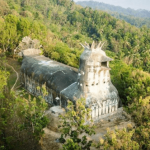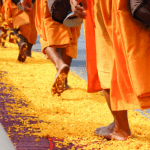 Creepy
Creepy  Creepy
Creepy  Technology
Technology 10 Scientific Breakthroughs of 2025 That’ll Change Everything
 Our World
Our World 10 Ways Icelandic Culture Makes Other Countries Look Boring
 Misconceptions
Misconceptions 10 Common Misconceptions About the Victorian Era
 Mysteries
Mysteries 10 Strange Unexplained Mysteries of 2025
 Miscellaneous
Miscellaneous 10 of History’s Most Bell-Ringing Finishing Moves
 History
History 10 Great Escapes That Ended Right Back in Captivity
 Weird Stuff
Weird Stuff 10 Fascinating Things You Might Not Know About Spiders
 Food
Food 10 Everyday Foods You Didn’t Know Were Invented by the U.S. Military
 History
History 10 Odd Things Colonial Americans Kept at Home
 Creepy
Creepy 10 More Representations of Death from Myth, Legend, and Folktale
 Technology
Technology 10 Scientific Breakthroughs of 2025 That’ll Change Everything
 Our World
Our World 10 Ways Icelandic Culture Makes Other Countries Look Boring
Who's Behind Listverse?

Jamie Frater
Head Editor
Jamie founded Listverse due to an insatiable desire to share fascinating, obscure, and bizarre facts. He has been a guest speaker on numerous national radio and television stations and is a five time published author.
More About Us Misconceptions
Misconceptions 10 Common Misconceptions About the Victorian Era
 Mysteries
Mysteries 10 Strange Unexplained Mysteries of 2025
 Miscellaneous
Miscellaneous 10 of History’s Most Bell-Ringing Finishing Moves
 History
History 10 Great Escapes That Ended Right Back in Captivity
 Weird Stuff
Weird Stuff 10 Fascinating Things You Might Not Know About Spiders
 Food
Food 10 Everyday Foods You Didn’t Know Were Invented by the U.S. Military
 History
History 10 Odd Things Colonial Americans Kept at Home
10 Pilgrimages Around the World That Aren’t Religious
When we think of pilgrimages, we often imagine spiritual journeys to sacred sites, but the concept of a pilgrimage can extend far beyond religion. A pilgrimage, in its most profound sense, is a journey or quest to discover something meaningful—whether it’s self-discovery, adventure, culture, or history.
All around the world, some paths draw people for reasons that aren’t tied to faith yet still offer transformative experiences. Here are 10 pilgrimages that allow travelers to walk in the footsteps of tradition, nature, and personal discovery without any religious affiliation.
Related: The 10 Most Sacred Pilgrimages from Different Faiths
10 Canterbury Trail
Perhaps the most famous pilgrimage in the Western world, the Canterbury Trail, also called the Pilgrim’s Way, goes through rural England and was popularized by Geoffrey Chaucer’s The Canterbury Tales.
The route was supposedly used by pilgrims across the country to reach the shrine of Thomas Becket in Canterbury, who was murdered in 1170. As English travelers came to pay their respects, the trail was solidified.
So, why is a funerary route from over a thousand years ago still significant? Though it was a niche part of British history when Chaucer wrote The Canterbury Tales in the 1400s, new interest in the trail was sparked. Chaucer’s collections of stories are told from the point of view of fictional pilgrims on their way to Canterbury from London. The beautiful prose and lilting verse of these stories made them instant classics, and even today, many visitors wish to retrace the steps of the Miller, the Knight, and the scandalous Wife of Bath.[1]
9 The Silk Road
The Silk Road, an ancient network of trade routes stretching across Asia, has long been a journey of cultural exchange. Though we no longer need to physically walk across the country to export and import goods, many history buffs and modern hikers enjoy the novelty and adventure involved in walking part or all of the trail.
Important ancient cities like Samarkand and Xi’an are on the way, allowing tourists to immerse themselves in history while sleeping in a comfortable hotel and having a hot meal. It’s a great way to explore the natural and diverse landscapes of Asia without necessarily delving into the spiritual, as the importance of commerce and culture cultivated through the Silk Road is almost as important as religion itself. (LINK 9) [2]
8 Trans-Siberian Railway
If you’re looking for a pilgrimage that requires no prior travel or hiking experience, look no further than the Trans-Siberian Railroad.
The longest railroad line in the world, adventure seekers can ride almost 6,000 miles (9,656 km) from Moscow to Vladivostok over the course of eight days. Comfort level depends on what cabins you book, but all classes include a bed and toilet.
Like the now-defunct Orient Express, the Trans-Siberian Railroad’s tumultuous but important history makes it a must-do for many visitors to Russia. In addition to being an everyday mode of transportation, taking the train is a way to catch an intimate glimpse into Russian towns you might not otherwise see on vacation while riding on a train that represents, to many, the interconnectedness and innovation of the largest country in the world.[3]
7 Kumano Kodo
Between the dazzling lights of Tokyo and the temples of Osaka, the lush nature of Japan is often forgotten. One way to avoid this oversight is to go a few miles south of Kyoto and embark on the Kumano Kodo.
Three separate shrines are at the center of the Kumano, all of which have drawn visitors throughout Japan’s long history. While visiting the shrines was an important part of the pilgrimage, Japanese people often pointed out that it wasn’t the goal. Rather, the trails were designed to be a life-changing experience in and of themselves, passing through difficult and even dangerous terrain.
In addition to the picturesque landscapes and ancient temples, the hardships endured and the rigor it takes to complete the Kumano Kodo makes it so popular today.[4]
6 Madonna del Ghisallo
Lake Como, Italy, is famous for its sweeping views and gorgeous weather. Perhaps, then, it should be no surprise that the most popular pilgrimage in the area isn’t really to the chapel of Madonna del Ghisallo but to the panoramic scene below.
In fact, most visitors to the chapel haven’t walked up the hill but cycled. Italian cyclists and ambitious out-of-towners flock to the Madonna del Ghisallo thanks to its grueling uphill bike route and rewarding view. Though you can just rent a bike and pedal to the top of the hill, most serious cyclists choose to go all the way from Rome, a six-day journey, to prove they have the strongest calves around.[5]
5 Lewis and Clark Trail
Meriweather Lewis and William Clark made history in the early 1800s with their legendary exploration of Western America. The two explorers set out from Pittsburgh to map new territory and find a western passage. They made it over 8,000 miles (12,875 km) to the Pacific Ocean.
Their work led to the discovery of new plants, animals, and landscapes and significantly expanded the U.S. government’s knowledge of the continent. Though their adventure across what would come to be the United States of America is not an easy one, in 2003, one American family set out to retrace their steps.
The Rooneys’ “Journey of Rediscovery” was documented by the Heinz History Center. They made their way across the rugged landscape with modern amenities that Lewis and Clark weren’t afforded but still managed to find new appreciation for the history of their country. Thanks to them, the National Park Service now has a Lewis and Clark National Historic Trail that visitors can follow from the East to West Coasts to learn more about the duo and explore the country.[6]
4 Mount Kailash
Nestled within the famous Himalayas, Mount Kailash is located near the tri-junction of China, India, and Nepal.
Being so close to three different countries, it makes sense that the mountain has been part of Hinduism, Buddhism, Jainism, and Bon. Three of these four religions believed Kailash to be the birthplace and home of deities, while the indigenous Bon religion of Tibet honors it as the seat of the creator of the universe. Buddhists believe that if you can climb the mountain 108 times, you will reach Nirvana, a transcendent state with no suffering or desires.
Though its roots are certainly rooted in spiritualism, most modern pilgrims climbing to the peak of Mount Kailash are not seeking a god or actual heaven but hoping to find happiness and Nirvana within themselves.[7]
3 Route 66
Being the fourth largest country in the world, the United States of America is particularly difficult to explore. From the hustle and bustle of New York City to the laid-back beaches of California, the vast size of America means if you only visit once or twice, you’ll undoubtedly miss out on something. While most tourists choose to fly into one or two cities and then go back home, many Americans know a secret they don’t—Route 66.
Route 66, also called the “Main Street of America,” spans 2,400 miles (3,862 km), starting in Chicago, Illinois, and ending in Santa Monica, California. The road goes through eight states and multiple types of landscapes, offering a diverse snapshot of the country.
As road trips became more popular throughout the 1950s and ’60s, Route 66 became the premier way to see not just nature but true Americana. Advertisements, diners, weird roadside attractions, motels, and souvenir shops popped up, furthering the road’s popularity. When the interstate highway system began in the 1960s, Route 66 fell out of practical use. You could travel faster on the new roads. By 1985, Route 66 was officially decommissioned, leaving once-thriving towns desperate for tourism.
Despite this, the road is still quite popular. Many Americans looking for a slice of classic Americana or off-beat adventures find themselves in these dilapidated towns, talking to folks who remember the good old days.[8]
2 Inca Trail
When you think of Peru, you no doubt imagine the beautiful ruins of Machu Picchu. This “Lost City of the Incas” is nestled in the Andes Mountains and is located about 26 miles (42 km) away from the nearest big city of Cusco.
Though there are ways to get to Machu Picchu without a lot of physical labor (such as plane, train, or bus), for the majority of visitors, the road is just as important as the destination. Every year, thousands of hikers make their way to the 15th-century Incan city and imagine themselves as ancient Peruvians. The Incans focus on nature and humans’ relationships with man-made wonders and the natural world, making the road to Machu Picchu one of the world’s most peaceful yet adventurous walks.[9]
1 The Camino de Santiago
Also known as The Way of St. James, the Camino de Santiago has multiple routes spanning up to four countries.
The origins of the Camino stretch back to the 9th century. Christian pilgrims began traveling to Spain in search of St. James’s tomb, which was allegedly in the northwest area of the country. Christians from all over Europe walked across the continent to prove their penance and devotion to God in the only way they knew how.
Because the route was completed by so many people so long ago, there’s no right or wrong way to do it. Some modern routes start in France and go through Italy, while others begin in Portugal. The shortest route starts and ends in Spain, sparing travelers passport or visa issues.
Though the origins of the Camino are religious, most walkers complete the Camino today primarily for personal reflection and adventure. According to a recent study, about 80% of pilgrims on the Camino are not religious. From staying in centuries-old hostels to meeting other hikers, being alone with your thoughts and the European scenery makes for a once-in-a-lifetime opportunity that makes the Camino a bucket list item for many.[10]








